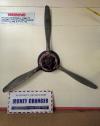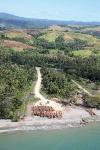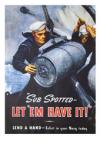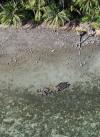|
|
 |
 |
 |
 |
 |
 |

 |
 |
 |
|
|
 |
|
|

Click on photo to view the original size. |
| Viewers
|
|
 |
 |
|
|
 |
|
 |
 |
 |
Read what others had to say:
|
 |
|
 |
 |
 |
 |
 |
Nickens, Dan - Sep 27,2015
Viewers
| Reply
 |
| |
The only international airport for the Solomon Islands is in the capital city, Honiara, on Guadalcanal. The airport was completed by the occupying Japanese engineers and Korean labor on August 6, 1942. The U.S. Marines landed on Guadalcanal and took it from them on August 7, 1942. The Marines renamed it Henderson Field after the first Marine aviator killed in the Pacific War during the battle of Midway.
The airport was abandoned by the military after the war. It was reopened in 1969 as the only international airport for the Solomon Islands. It is now referred to as Honiara/Henderson International Airport. Rumor has it that there have been complaints that it should be called by its Japanese name since they built it. A local guide told me nobody would really care if that happens. Seven decades is apparently long enough for old enmities to be die.
The prop from a downed Japanese Zero is on display at airport. It's not easy to find stuffed in between signs against a dirty wall.
It was an inauspicious start to find a rundown third world airport. It didn't get any better traveling over the major road into town, filed with potholes, traffic jams and surrounded by squalor.
On the way into town there were some infrastructure improvements being made by the Chinese. Signs written in English proclaimed the good civics work the Chinese government is doing. It seems geopolitical realities are subject to major shifts after seventy years.
| | Attachments:

Desecrated Prop
| | |
 |
Nickens, Dan - Sep 27,2015
Viewers
| Reply
 |
| |
The first test flight was just around the northwestern coast of Guadalcanal near Honiara, so I didn't expect to see much. Wrong. There were three ship wrecks along the shore in just the first ten miles.
One was a Japanese freighter that ran ashore to keep from sinking after being attacked. The Kinugawa Maru was part of a convoy of eleven ships bringing supplies to Guadalcanal on November 13, 1942. The convoy was spotted by an American reconnaissance plane and attacked by aircraft from the U.S.S. Enterprise. Seven of the convoy ships were sunk, but the Kinugawa slipped through to offload her troops. She was caught doing that on November 15 by U.S. Marine shore batteries and heavily damaged. Airstrikes were called in and a U.S. destroyer came by to finish the job. The captain of the Kinugawa decided to drive his ship onto the shore rather than let her be sunk. For some reason during the 1960's salvers took the upper deck off.
This part of the Canal was held by the Japanese when the Marines took Henderson Field. The main Japanese base at Raubal sent supplies southeast down the sound between the islands. Sinking of the supply ships left the troops without provisions or ammunition. If the ships got through, supplies had to be taken overland through the tropical jungle over ridges to the fighting at the airport. Many of the casualties on the Japanese side were from starvation and malaria. Some of the starving troops began sneaking into the U.S. encampment, not to kill, but to steal food. This gave rise to stories of thieving ghosts.
| | Attachments:

Japanese Freighter
| | |
 |
Nickens, Dan - Sep 27,2015
Viewers
| Reply
 |
| |
War isn't the only reason for ship wrecks. This boat was driven ashore by forces of a more mundane source.
| | Attachments:

Not a Just War
| | |
 |
Nickens, Dan - Sep 27,2015
Viewers
| Reply
 |
| |
After lunch the wind starting picking up. The waves got confused between the wind and the swell. It was time to put the water toys away.
| | Attachments:

Roughness in the Afternoon
| | |
 |
Nickens, Dan - Sep 27,2015
Viewers
| Reply
 |
| |
It wasn't just the wind that came in the late afternoon. Showers moved from over the island's ridges to the surrounding waters.
| | Attachments:

Sunset Showers
| | |
 |
Nickens, Dan - Sep 27,2015
Viewers
| Reply
 |
| |
The capital of the Solomon Islands was moved by the British to Honiara after the war. The original capital across the sound at Tulagi just wasn't big enough, and the hastily constructed wartime infrastructure on Guadalcanal was sufficient reason to make the move.
| | Attachments:

Downtown Parking
| | |
 |
Nickens, Dan - Sep 27,2015
Viewers
| Reply
 |
| |
The downtown waterfront featured a big boat driven through a pier, likely a consequence of peacetime stresses?
| | Attachments:

Bad Parking
| | |
 |
Nickens, Dan - Sep 27,2015
Viewers
| Reply
 |
| |
Even the Yacht Club had its own derelict wreck. None of the locals I talked to mentioned a recent tsunami to account for the wreckage. There was, however, much discussion of a flash flood of the Mataniko River, killing scores of people living on its downtown banks. The flooding was attributed to excessive logging in the mountains by Chinese companies.
| | Attachments:

Yacht Club Parking
| | |
 |
Nickens, Dan - Sep 27,2015
Viewers
| Reply
 |
| |
Sunga was hired as a local guide and consultant to accompany us on SuRi. It was his first flight in a seaplane. He loved it.
| | Attachments:

Local Flyer
| | |
 |
Nickens, Dan - Sep 27,2015
Viewers
| Reply
 |
| |
There was large agriculture, coconut plantations and cocoa farms, but most of the farms were small family plots. This was the only aquaculture I saw. Sunga told me they are growing water cress.
| | Attachments:

Water Gardens
| | |
 |
Nickens, Dan - Sep 27,2015
Viewers
| Reply
 |
| |
Like most tropical islands the shores are usually guarded by shallow reefs. This limits water approaches by amphibious assault vehicles, including SeaReys.
| | Attachments:

Coastal Barriers
| | |
 |
Nickens, Dan - Sep 27,2015
Viewers
| Reply
 |
| |
There were brightly colored squares covering many of the beaches and river banks. I asked the Sunga about them. He told me the natives saw the Marines doing that during WWII and had adopted the custom.
| | Attachments:

Natural Clothes Dryer
| | |
 |
Nickens, Dan - Sep 27,2015
Viewers
| Reply
 |
| |
The jungle on Guadalcanal is nearly impenetrable. It is thick with everything green and smells of rotting vegetation. There are tangles of vines, snakes, malarial ridden mosquitoes, crocodiles, and razor sharp saw grass in open areas, mixed with steep slopes, quicksand, and vertical rock ridges baking in tropical heat and humidity combining to keep all but the most stalwart out. There are no interior roads other than the one built by the invading armies along the coast. People live next to the beaches or on shallow, short rivers.
It's not all peace and loving between the Solomon Islanders. From 1998 to 2003 "the Tensions" raged on Guadalcanal. Conflict arose between the local natives and immigrants from other islands, particularly Malatia. The immigrants retreated to Honiara and formed their own paramilitary force. The situation deteriorated despite multiple attempts at settlements and the country descended into general lawlessness. Conflict spread to other islands until finally, in 2003, with the country bankrupt and in chaos, the government requested international intervention.
Australia led a coalition of Pacific countries in "Operation Helpem Fren" to restore order. More recently (2006) ethnic tensions mounted over Chinese businessmen and riots broke out. China sent in chartered flights to evacuate its citizens. Australia, New Zealand and Fiji sent in more policemen to quell the violence.
All seemed peaceful enough offshore aboard SuRi. In between us and town was a friendly Australian gunboat.
| | Attachments:

Interior Village
| | |
 |
Don Maxwell - Sep 27,2015
Viewers
| Reply
 |
| |
Rectilinear buildings, each with its own orientation. So do they submit to a requirement for right angles, or not?
| | |
 |
Nickens, Dan - Sep 28,2015
Viewers
| Reply
 |
| |
Curvilinear structures are allowed, Don. Quonset huts may still be found in use anywhere the U.S. military moved in for more than a few days.
| | |
 |
Nickens, Dan - Sep 27,2015
Viewers
| Reply
 |
| |
The jungle can be beat back. Logging is a major source of revenue for the Solomons. Chinese companies are happy to help. Heavy equipment and fire bares the hills. When the rains come, the flash flooding washes away the soil and people living in the narrow gullies and river valleys.
There is some danger in any activity on the old battlefields. Munitions are constantly being found and uncovered. An explosive ordinance disposal team paid for by the Australians is still dealing with dangerous war relics.
| | Attachments:

TerraTransformation
| | |
 |
Nickens, Dan - Sep 27,2015
Viewers
| Reply
 |
| |
It was not all about horrors of war long past and ethnic violence. Present elements of beauty abound.
| | Attachments:

Peaceful Ending
| | |
 |
Kenneth Leonard - Sep 27,2015
Viewers
| Reply
 |
| |
Great stuff as usual Dan. Living the dream. Sorry there seems to be poor self-governance though. Certainly the islanders have not
had it easy.
| | |
 |
Mike Reisz - Sep 28,2015
Viewers
| Reply
 |
| |
Thanks for posting. It is a nice read and you get great pictures.
| | |
 |
Nickens, Dan - Sep 28,2015
Viewers
| Reply
 |
| |
Savo island blocks the horizon in the sound running down the middle of the Solomon Islands. It was a convenient waypoint for a SeaRey crossing to the Florida Islands when SuRi left without me (Oh Yeah!).
During the WWII "Battle of the Five Sitting Ducks" Japanese warships used the island to block their approach to Guadalcanal. Attacking at night from behind the island, the Japanese surprised the Allied ships to terrible effect.
| | Attachments:

Horizon Obscuration
| | |
 |
Nickens, Dan - Sep 28,2015
Viewers
| Reply
 |
| |
Under cover of midnight on August 6, and hidden by storms, a Marine amphibious force attacked Guadalcanal and the Japanese seaplane base at Tulagi in the Florida Islands. The entire operation was called "Operation Shoestring" by the troops because most of their support and supplies was siphoned off for other battles, including the ones Roosevelt was focused on in Europe. Many in the Allied Pacific Command didn't believe the attack could succeed and it got little support. The orphaned invading force had endured a dockworker strike as they prepared to launch from New Zealand. Without the support of the dockworkers they were trying to defend, supplies were loaded by sailors and troops in a pouring rain, ruining many of the supplies. As a result they started the campaign short of naval support, ammunition and most provisions.
Counterattacks by Japanese aircraft on August 7 and 8 convinced Admiral Fletcher to withdraw his defending aircraft carriers on August 8. The Allied supply ships decided that this was their clue to evacuate ASAP, leaving the Marines with less than half of their 10 days of supplies, heavy equipment, and canons.
In response to the Marines' assault, a Japanese armada sailed southeast from their base at Rabual on New Britain to intervene. Through the New Georgia Sound, also known as "the Slot", Japanese ships of war would run the gauntlet through the Solomon Islands between the two sides of the natural channel. On the night of August 8, as the Allied supply ships were hurriedly offloading in preparation for departure, the Japanese fleet slipped around Savo and decimated the warships screening the transports. One Australian and three American cruisers were sunk. Another heavy cruiser was so heavily damaged that it was scuttled. The result was a major naval defeat for the Allies.
Over a thousand Allied sailors were killed. The Japanese suffered only light damage and less than 60 sailors killed in the action. Instead of pressing their attack, however, the Japanese fleet withdrew without attacking the transports. The Allied transports pulled out on August 9. An overwhelming naval victory was lost strategically when the Japanese commander failed to press his advantage.
Seventy three years later to the day, the island peacefully occupied the SeaRey's horizon.
| | Attachments:

Iron Bottom Sound
| | |
 |
Nickens, Dan - Sep 28,2015
Viewers
| Reply
 |
| |
Plantations growing coconuts look like a major source of income for Savo islanders. Or, if not, they have plenty of coconut to eat.
| | Attachments:

Coconut Glut
| | |
 |
Nickens, Dan - Sep 28,2015
Viewers
| Reply
 |
| |
Another sinking boat joining the horde of steel rusting on the bottom of Ironbottom Sound? No. Just some kids playing on Savo's shore.
Swimming in water full of ghosts? It's amazing how the decades change the scenery. Or not. Likely the same scene played out in the thousand years before the war. And again today. As if the fierce battles never happened.
| | Attachments:

Learning to Swim
| | |
 |
Nickens, Dan - Sep 28,2015
Viewers
| Reply
 |
| |
Friendly waves were common from the women cleaning clothes on the beach.
| | Attachments:

Beachlife
| | |
 |
Nickens, Dan - Sep 28,2015
Viewers
| Reply
 |
| |
A short boat ride from Guadalcanal, but a voyage of eternity for the sailors that didn't see August 9 seventy three years back.
| | Attachments:

Rounding Savo
| | |
 |
Nickens, Dan - Sep 28,2015
Viewers
| Reply
 |
| |
Mbike Island is one of the Florida Islands (or "Nggela Islands," if you can say that). It has a nice Florida like look to it, without all the condos.
| | Attachments:

UnFloridaLike
| | |
 |
Nickens, Dan - Sep 28,2015
Viewers
| Reply
 |
| |
Sunga told me that the native islanders like Americans and the Allies. They were well treated during the war, as opposed to their enslavement by the Japanese invaders. The thing is that now most tourists to the Solomons come from Japan. Relatives of the dead come regularly to pay their respects. They have greatly rehabilitated their nation's reputation with the natives.
| | Attachments:

Friendly Folk
| | |
 |
Nickens, Dan - Sep 28,2015
Viewers
| Reply
 |
| |
Magma crusting over ash? I didn't have time to investigate. As slow as SuRi was crossing the New Georgia Sound, I was slower with my far flung detours.
| | Attachments:

Crusty Rock
| | |
 |
Nickens, Dan - Sep 28,2015
Viewers
| Reply
 |
| |
There are a limited number of places from which to make an amphibious assault. This was not one of them.
| | Attachments:

Jagged Coast
| | |
 |
Nickens, Dan - Sep 28,2015
Viewers
| Reply
 |
| |
Tulagi was the original capital of the Solomon Islands. The Japanese maintained a seaplane base with floatplanes between the islands. It was a target for simultaneous invasion along with Guadalcanal. The Allied invaders found much fiercer resistance at the capital than from the engineers and construction crews at Henderson Field. As it turned out, however, the battle for Tulagi and its seaplane base was not as important as the battle for Henderson Field on Guadalcanal. That was a just a precursor to the general decline of importance of seaplanes (until now!).
From the looks of the town, it never recovered from the war wounds. It just continues to add wreckage to its coastline.
| | Attachments:

Recent Wreckage
| | |
 |
Nickens, Dan - Sep 28,2015
Viewers
| Reply
 |
| |
It's not always easy to distinguish wrecks from repair works in progress. Definitely not WWII vintage....except for maybe the steel ship nearby.
| | Attachments:

Boats Ashore
| | |
 |
Nickens, Dan - Sep 28,2015
Viewers
| Reply
 |
| |
Sunk at dock? Or just settling at dock.
| | Attachments:

Last Dockage
| | |
 |
Nickens, Dan - Sep 28,2015
Viewers
| Reply
 |
| |
LST-342 was torpedoed off New Georgia on July 18, 1943 (LST = "Landing Ship, Tank" or "Large Slow Target" . The explosion blew it in half and stern section sank, but the bow remained afloat. The bow was towed to Purvis Bay to salvage useable equipment. The missing stern section housed most of the crew. A model of LST-342 can be found at the Hampton Roads Naval Museum ( http://hamptonroadsnavalmuseum.blogspot.com/2012/11/uss-lst-342-ship-model.html ) . The explosion blew it in half and stern section sank, but the bow remained afloat. The bow was towed to Purvis Bay to salvage useable equipment. The missing stern section housed most of the crew. A model of LST-342 can be found at the Hampton Roads Naval Museum ( http://hamptonroadsnavalmuseum.blogspot.com/2012/11/uss-lst-342-ship-model.html )
Before it broke in half, the LST-342 was 328' long with a complement of 13 officers and 104 enlisted men. Fortunately there only "several dozen casualties" including 5 African-American mess crew and Navy combat artist McCelland Barclay.
Mr. Barclay was an artist of some notoriety. He produced recruitment posters for the military and movie industry, images for popular periodicals, and the advertisement industry. Though he was over 50 years old, he went to war with the Navy, proclaiming " "A camera cannot catch the human element of a fight, the sweat and blood and courage our boys expend every time they face the enemy." One of his posters seems to portend his fateful encounter with the submarine.
Perhaps some of the mess crew were artists with food. All lost on the LST had valuable lives that were expended in furtherance of the war effort.
| | Attachments:

Hamptons Road Model
| |
| Attachments:

Last Landing

Sub Spotted Poster by McCelland Barclay
| | |
 |
Nickens, Dan - Sep 28,2015
Viewers
| Reply
 |
| |
Wasting away in shallow water were a couple of tracked vehicles. One looks like a tracked trailer. Maybe the other was a tank, or maybe it was just a tractor. Were they stopped in their tracks by hostile action, or by mechanical fault, or simply left in place when the troops moved on? There were native huts nearby. No one thought they were worthy of salvage? I didn't stop to find clues to as their story.
| | Attachments:

Busted Tracks
| | |
 |
Nickens, Dan - Sep 28,2015
Viewers
| Reply
 |
| |
A barge rusting in the shallow water showed no obvious signs of war damage. There was plenty of evidence, however, of the blasting of saltwater. To paraphrase Carl Sandburg: "I am the sea.....see me work."
Or why paraphrase at all:
Grass
By Carl Sandburg
Pile the bodies high at Austerlitz and Waterloo.
Shovel them under and let me work-
I am the grass; I cover all.
And pile them high at Gettysburg
And pile them high at Ypres and Verdun.
Shovel them under and let me work.
Two years, ten years, and the passengers ask the conductor:
What is this place?
Where are we now?
I am the grass.
Let me work.
Source: Cornhuskers (1918)
| | Attachments:

Blasted Barge
| | |
 |
Nickens, Dan - Sep 28,2015
Viewers
| Reply
 |
| |
A stone pattern in the shallow water is all that remains of what was once a substantial dock. A victim of bombs? Or typhoons? Or salvagers?
| | Attachments:

Dock Debris
| | |
 |
Nickens, Dan - Sep 29,2015
Viewers
| Reply
 |
| |
The original focus of the Allied assault was the seaplane base at Tulagi. It hosted fifteen A6M2-N Rufe floatplanes. All were destroyed in the battle. Two of the Rufe's (Zeros on floats) were salvaged and shipped to Alameda, CA by the U.S. Navy. SuRi's guests went diving on two of those that remain where they sank.
The Halavo Seaplane Base, Florida Island or Tulagi Seaplane Base later serviced PBYs. None are reported to be lying under the lagoon's waters.
I can confirm that the protected water makes an excellent water base of operations for seaplanes, particularly when no one is shooting at you.
| | Attachments:

Seaplane Facilities
| | |
|
|
|

|
 |
 |
 |
|
|
|
|
| |
- About Searey.us -
- Contact Searey.us -
|
- Privacy Statement -
- Terms of service -
|
Copyright © 2024 Searey.us & Brevard Web Pro, Inc. -
Copyrights may also be reserved
by posters and used by license on this site. See Terms of Service for more information.
|
| |
- Please visit our NEW
Chapter Place Website at: chapterplace.com or
Free Chapter Management Website at: ourchapter.org. Good for all chapters, groups or families. |
| | | | | | | | | | | | | | | | | | | | | | | | | | | | | | | | |